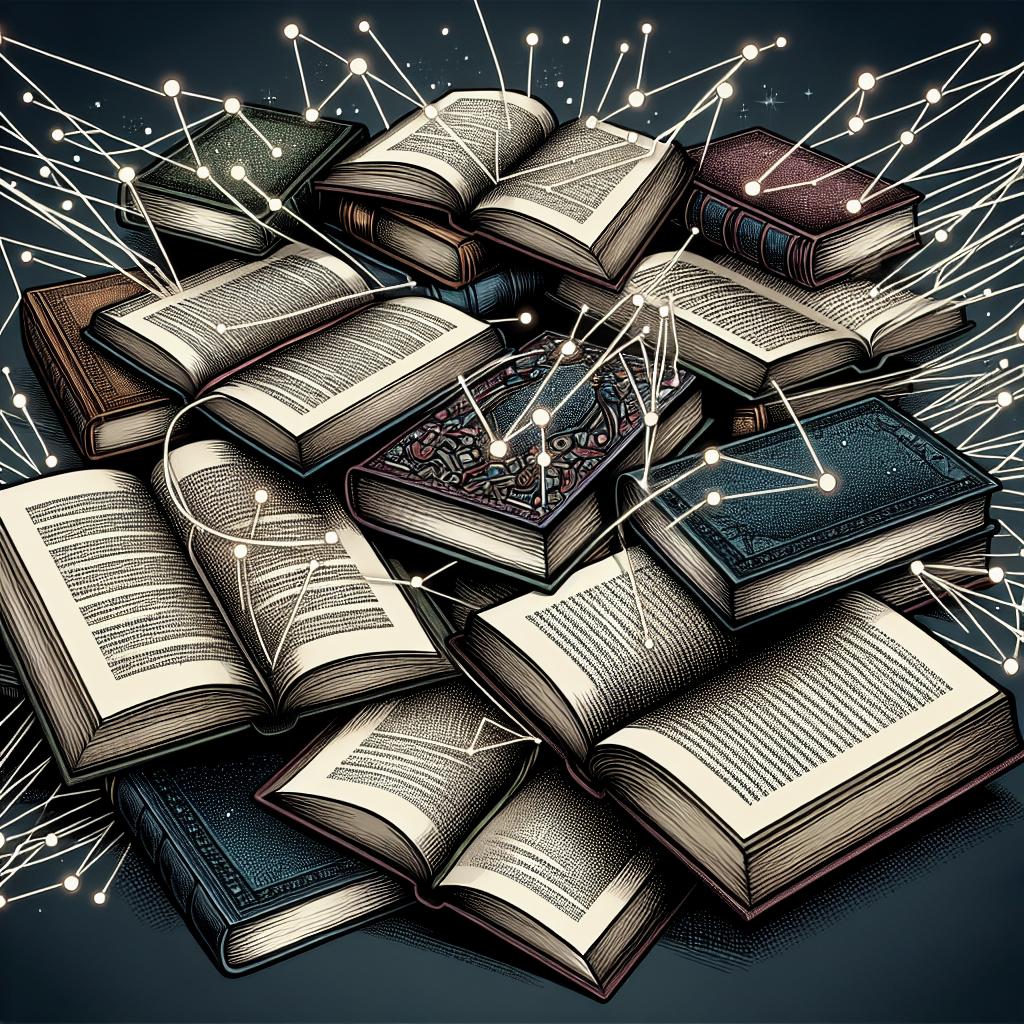Intertextuality is a concept frequently explored within the realms of literature, film, television, and even video games. It refers to the relationship between texts and how they influence, reference, or transform one another. This blog post delves into intertextuality, breaking down its definition, types, and how it manifests across different media. We explore specific examples from literature, where the layering of stories adds depth and richness. In television, cinematic influences create unique storytelling methods. Films often draw intertextually from one another to offer new perspectives or critiques, while video games use these references to evoke nostalgia and craft layered narratives. Following these explorations, we’ll touch on subtext, a related concept that can provide additional layers of meaning in narratives. If you’re a writer or content producer, understanding intertextuality can enrich your storytelling approach, and we’ve got tips on creating and managing your scripts too. Dive in to explore these fascinating interconnections in storytelling. ### Intertextuality Definition #### First, let’s define intertextuality Intertextuality is the tapestry of connections and links between texts. Originally coined by the literary theorist Julia Kristeva in the 1960s, it signifies how texts influence or reference each other, creating a web of resonance and meaning. Intertextual references can enhance a reader’s understanding or experience of a text, often by invoking additional works, themes, or styles. This mechanism is not restricted to a single form of media but spans literature, film, television, and games, among others. Understanding intertextuality involves recognizing that texts do not exist in isolation but are part of a larger dialogue within cultural and historical contexts. When a text references others, it not only borrows and builds upon previous ideas and structures but also contributes to an ongoing creative conversation. This interaction can be explicit, with direct quotations or allusions, or it can be more subtle, employing similar themes, motifs, or even narrative structures. #### What is intertextuality? At its core, intertextuality reveals how texts perform an intricate dance of meaning-making that transcends their individual boundaries. Texts can adopt, transform, contradict, or pay homage to each other, allowing authors to draw on a rich tapestry of cultural references while encouraging audiences to engage with the content on multiple levels. This process can generate new interpretations and inspire fresh insights for both creators and consumers. Intertextuality can manifest as quotations, allusions, pastiches, or parodies. Recognizing these can deepen one’s understanding of a text and its place within broader cultural narratives. By engaging with intertextuality, creators open new avenues for storytelling, inviting audiences to explore beyond the single text at hand and into the larger network of literature, film, television, or gaming. ### Types of Intertextuality #### What are the types of intertextuality? Intertextuality can be categorically divided into various types, each offering unique avenues for interaction between texts. One of the primary forms is allusion, where a text references or hints at another work, explicitly or implicitly. This could involve citing a famous line, evoking a particular theme, or referencing a known character or storyline. Allusions require the audience to have prior knowledge of the referenced work to fully appreciate the depth of meaning. Another type is pastiche, which involves imitating the style or content of another text. Unlike parody, which mocks or critiques, pastiche respects and celebrates the source material, often using it as a homage. Films, novels, and even games can employ pastiche to create an effect of familiarity and nostalgia, drawing audiences into a comfortable, recognizable environment. Parody is yet another form that takes a more satirical approach. Through exaggeration and humor, parody mimics the original text, highlighting its idiosyncrasies or blemishes for comedic or critical effect. This form of intertextuality offers a platform for critique as well as entertainment, encouraging audiences to rethink and reinterpret the original work from a new perspective. ### Intertextuality in Literature Examples #### What is intertextuality in literature? In literature, intertextuality serves as a tool for authors to create deeper meaning and complexity within their narratives. Works of literature often engage in intertextual dialogues with earlier or contemporary texts, inviting readers to make connections and draw insights across different stories. For instance, James Joyce’s “Ulysses” is famously woven with layers of intertextuality, drawing heavily from Homer’s “Odyssey” as it recreates the hero’s journey in a modern setting. Shakespeare’s plays are rife with intertextual elements, often incorporating or reinterpreting existing stories, myths, and historical accounts. Examples include “Romeo and Juliet,” which draws on earlier Italian tales of star-crossed lovers, and “Hamlet,” which bears influences from Norse sagas as well as classical works. These intertextual layers offer historical resonance and cultural commentary, enriching the audience’s engagement with the plays. Intertextuality is not limited to classical texts but permeates contemporary literature as well. Modern authors frequently reference each other’s works, creating a literary network that spans genres and periods. For example, in Margaret Atwood’s “The Handmaid’s Tale,” intertexts with biblical tales underscored the narrative’s examination of themes like power and control. Such intertextuality invites readers to interpret and question familiar aspects of their culture and history. ### TV Referencing Cinema #### Intertextuality examples in television Television and cinema share a symbiotic relationship that frequently involves intertextuality. TV series often reference or pay homage to films, creating a shared universe or exploiting familiar tropes for dramatic or comedic effect. For instance, the cult-favorite series “The Simpsons” excels at intertextuality, with its episodes often parodying famous films like “The Godfather” and “Star Wars,” bringing humor and depth to its narrative by drawing on cinematic history. Another example is the series “Stranger Things,” which extensively references 1980s films like “E.T.” and “The Goonies,” invoking nostalgia while also crafting an original storyline. These intertextual elements are woven seamlessly into the series, enriching its setting and character development while connecting with a wide range of audience experiences. The blending of these cinematic references helps create a compelling narrative that feels both fresh and familiar. Television’s use of intertextuality is also evident in how certain series draw stylistic and thematic inspiration from films. “Breaking Bad,” for example, employs visual and narrative techniques reminiscent of crime dramas, adding layers of tension and complexity to its unfolding storyline. By referencing familiar cinematic conventions, TV shows can enhance their storytelling and create multidimensional experiences for viewers. ### Intertextual Films #### Intertextuality examples in movies Films are a rich platform for intertextuality, frequently alluding to or borrowing from other films and cultural texts. Quentin Tarantino’s movies are exemplary in this regard, with “Pulp Fiction” featuring homages to a slew of cinematic classics, ranging from noir to spaghetti Westerns. These intertextual references contribute to the film’s distinctive style and narrative complexity, inviting audiences to explore the interplay between films and genres. The “Shrek” series offers another fascinating exploration of intertextuality. Known for its playful parodies of fairy tales and Disney movies, “Shrek” subverts traditional narratives while crafting an insightful commentary on the genre. Through such intertextual engagement, “Shrek” maintains an inventive, entertaining atmosphere that resonates with audiences of all ages who are familiar with the original tales. Intertextuality in films can also extend beyond direct references to thematic inspiration. For instance, Christopher Nolan’s “Inception” was inspired by Japanese anime and philosophical texts, blending diverse elements to construct a unique storytelling experience. By utilizing intertextuality, film directors enrich their narratives, add layers of meaning, and create a dialogic interaction with the cinematic canon. ### Intertextual Examples in Games #### Intertextuality examples in games Video games, a dynamic medium rich with storytelling potential, frequently leverage intertextuality to enhance their narratives. Popular game series like “The Legend of Zelda” often include nods to mythology and classic literature, providing players with an enriched understanding of the game’s story world. These references deepen players’ connections to the narrative and create a compelling context that echoes traditional epic tales. The “Assassin’s Creed” series is another brilliant example, intertwining historical events with fictional storytelling and echoing various films and novels about those periods. Such intertextuality not only enriches the gameplay experience but also educates players about different historical contexts, offering a complex tapestry that merges fact with fiction. Moreover, games like “BioShock” explore heavier themes through intertextual connections with philosophical texts and dystopian literature. Drawing on works such as Ayn Rand’s “Atlas Shrugged,” the game crafts a haunting narrative that probes issues of objectivism and societal structure, engaging players on an intellectual level while they navigate the virtual world. ### Up Next #### What is Subtext? Subtext functions as a related concept to intertextuality, existing as the underlying or implicit meaning within a narrative. It acts as a subtle thread of additional meaning, guiding audiences to interpret stories beyond the immediate dialogue and action. Understanding subtext allows audiences to perceive the multi-layered nuances that might not be overtly expressed but are crucial to the overall narrative impact. While intertextuality involves connections between different texts, subtext delves into the deeper implications within a single work. It invites audiences to read between the lines, often revealing character motivations, societal critiques, or philosophical themes that provide depth to the surface narrative. This layered exploration can make the storytelling experience richer and more engaging. Writers can utilize subtext to create tension, convey emotions, or impart messages without direct exposition. By weaving subtext into dialogue, setting, or character interactions, creators can craft stories that resonate on multiple levels, requiring audiences to engage actively and interpret complex emotional and thematic undertones. ### Write and produce your scripts all in one place. As a creator, harnessing the power of intertextuality and subtext can significantly enhance your storytelling toolkit. Crafting narratives that resonate on multiple levels is not only rewarding but also attracts an engaged audience looking for rich, symbolic content. If you’re keen on developing these skills, platforms like Celtx and Final Draft offer comprehensive resources for writing and producing your scripts efficiently. These tools enable you to organize your work, integrate feedback, and maintain consistency throughout your production process. By centralizing script development, you can seamlessly incorporate intertextual references and layered subtext, streamlining the creative workflow from concept to execution. Such platforms are invaluable for writers aiming to produce captivating, intricate stories that draw on a tapestry of intertextual influences and subtextual depth. Finally, embracing the intricacies of intertextuality and subtext in your creative endeavors can lead to groundbreaking narratives with lasting impact. Whether you are crafting novels, screenplays, or games, understanding these narrative elements opens a world of possibilities for complex, engaging storytelling.
| Section | Content |
|---|---|
| Intertextuality Definition | Explains the meaning and significance of intertextuality. |
| Types of Intertextuality | Describes different forms like allusion, pastiche, and parody. |
| Intertextuality in Literature Examples | Explores intertextuality in works by Joyce and Shakespeare. |
| TV Referencing Cinema | Discusses TV series like “The Simpsons” and “Stranger Things” using intertextuality. |
| Intertextual Films | Highlights movies like “Pulp Fiction” and “Shrek” for cinematic intertextuality. |
| Intertextual Examples in Games | Details video games like “The Legend of Zelda” and “Assassin’s Creed”. |
| Up Next | Introduces the concept of subtext as related to intertextuality. |
| Write and produce your scripts all in one place. | Discusses tools for enhancing narrative through intertextuality and subtext. |


